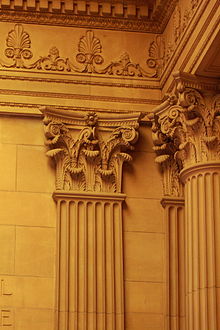Pilaster
In classical architecture, a pilaster is a rectangular support that resembles a flat column. It includes the usual features of a classical column; a capital at the top, the shaft of the column itself, a base and a plinth, but it usually only projects a third of its width or less from the wall.
Pilasters are traditionally used for decorative rather than structural purposes, often as a means of breaking up an otherwise empty expanse of wall. As with columns, different classical orders can be represented, and the surface of a pilaster can be left plain or can be fluted.
The term ‘canton’ refers to a pilaster that appears at the corner intersection of two walls.
Roman architecture made common use of pilasters, as did Renaissance Europe where they became popular on both interior and exterior walls, and as a feature of the Greek Revival style.
NB Short Guide, Scottish traditional shopfronts, published, on 18 April 2017 by Historic Environment Scotland, suggests that a pilaster is : ‘A column, shaft and base which projects slightly from the wall but is generally not structural in nature. Used for shopfront design particularly from the 1850s onwards. May be decorated or plain, often with fluting or reeding.’
[edit] Related articles on Designing Buildings
- Anta.
- Arcade.
- Architrave.
- Barrel vault.
- Bas-relief.
- Classical orders in architecture.
- Colonnade.
- Corbel.
- Cornice.
- Cornice coving and architrave definitions.
- Crocket.
- Elements of classical columns.
- Entablature.
- Fillet.
- Fluting.
- Frieze.
- Italian Renaissance revival style.
- Moulding.
- Pedestal.
- Pediment.
- Soffit.
- Trompe l’oeil.
Featured articles and news
Infrastructure that connect the physical and digital domains.
Harnessing robotics and AI in challenging environments
The key to nuclear decommissioning and fusion engineering.
BSRIA announces Lisa Ashworth as new CEO
Tasked with furthering BSRIA’s impressive growth ambitions.
Public buildings get half a million energy efficiency boost
£557 million to switch to cleaner heating and save on energy.
CIOB launches pre-election manifesto
Outlining potential future policies for the next government.
Grenfell Tower Inquiry announcement
Phase 2 hearings come to a close and the final report due in September.
Progress from Parts L, F and O: A whitepaper, one year on.
A replicated study to understand the opinion of practitioners.
ECA announces new president 2024
Electrical engineer and business leader Stuart Smith.
A distinct type of countryside that should be celebrated.
Should Part O be extended to existing buildings?
EAC brands heatwave adaptation a missed opportunity.
Definition of Statutory in workplace and facilities management
Established by IWFM, BESA, CIBSE and BSRIA.
Tackling the transition from traditional heating systems
59% lack the necessary information and confidence to switch.
The general election and the construction industry
As PM, Rishi Sunak announces July 4 date for an election.
Eco apprenticeships continue help grow green workforce
A year after being recognised at the King's coronation.
Permitted development rights for agricultural buildings
The changes coming into effect as of May 21, 2024.






















